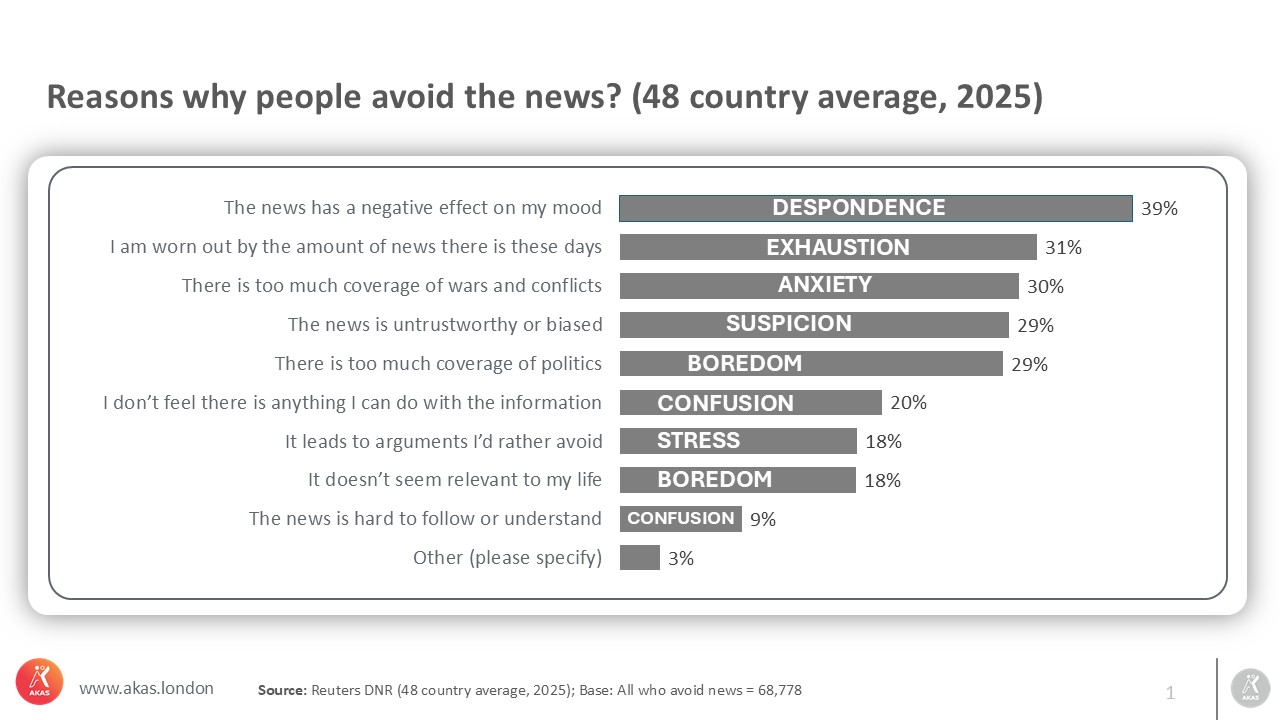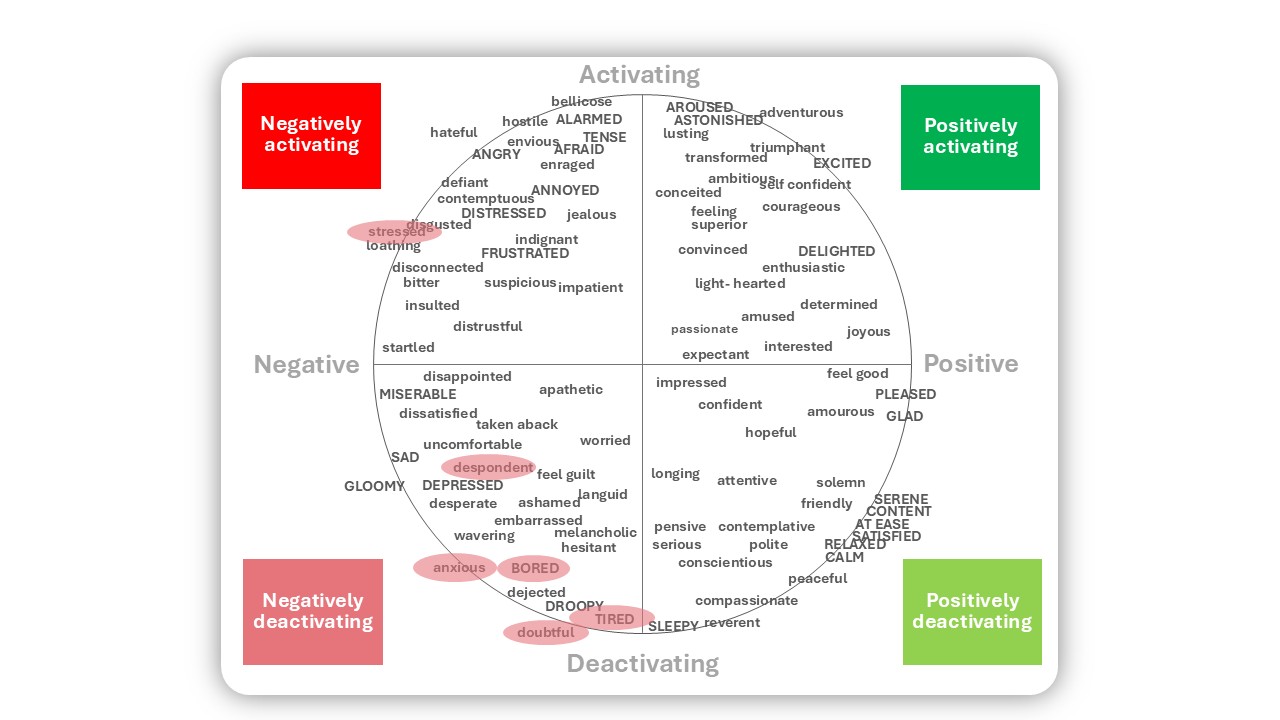The news industry is withering away. You know that. I know that. We worry, talk and write about it a lot. Between 2014 and 2024 global newspaper revenues declined by 29% and although some studies indicate modest growth over the next five years, the future of news is being called into question.
Cocooned in info bubbles, audiences, especially younger ones, are deserting news media and traditional platforms in their droves, disappearing into a black hole of proliferating disinformation-saturated social media and chatbot nets. We forensically analyse the reasons and unmet needs that drive audiences’ avoidance of news and seek remedies that include more positive news angles, anchored in offering solutions, more explainers and more audience-relevant news on as many platforms as resources allow.
All these lenses logically assessing audience (dis)engagement are important, but they fail to include arguably the most important element that lies at the core of human engagement – emotions. Engagement is attention and the emotions we feel galvanize that attention or don’t.
Despite the stratospheric speed at which humanity adopts cutting-edge technologies, we are remarkably slow at applying the revolutionary discoveries related to emotions that neuroscience has gifted us in the last few decades. Instead, we remain stuck in old thinking patterns that rest on the archaic belief that reason is superior to emotion, that reason must be in control for sound decisions, manifested in facts, to be made, while emotions are merely primal impulses that must be subjugated.
Scientific explanations this century have revealed that reason and emotions operate as a fully integrated decision-making system and emotions enable the discernment that reason relies upon. It is in fact emotions that assign value to facts, deeming them good or bad, significant or not. "You might think that in everyday life, the things you see and hear influence what you feel, but it’s mostly the other way around," says Lisa Feldman Barrett in her highly acclaimed, "How Emotions are Made."
The news industry is lagging significantly behind in understanding the integral role that emotions play in people’s decisions of whether or not to engage with the news, despite some of the best journalists grasping this concept, like The New York Times’ opinion columnist David Brooks who argues that we are only as smart as our emotions.
The popular historian and science writer Yuval Noah Harari also often reminds us that facts alone cannot engage, while the award-winning novelist and political scientist Elif Shafak attributes populists’ ability to engage large swathes of the population mainly to their masterful use of emotions. "As human beings we are emotional creatures and we should not forget that. Perhaps many of us have forgotten that," she warns. My fear is that journalism has done exactly that.
The overly fast-paced, impossibly competitive, under-resourced and headline-driven newsroom culture that teaches journalists to leave their emotions outside the door, ends up being dissociated from journalists’ own lived experiences and disconnected from individual people’s emotions. This is one fundamental reason why most of the industry is haemorrhaging audiences and will continue to do so until the audience editorial thinking changes, inviting emotions as a fully-fledged audience engagement metric to the user needs assessment party.
As a result of this disconnect between news offers and audience needs, consuming the news has become a test of emotional endurance and resilience for audiences. For example, according to a Pew Research survey from May this year, on average news makes Americans feel 4.1 times more negative emotions than positive ones. When consuming news, they are 3.6 times more likely to feel confused than empowered and 5.4 times more likely to feel sad than happy.
In my quest for new insights, I decided to apply an emotions-analysing lens to findings from the robust Reuters Digital News Report (DNR) 2025 survey and then map the results onto an accessible academic model for assessing emotions. One of the important questions the DNR asked the 40% of audiences across 48 countries who reported avoiding news was why they avoid the news.

The responses clustered around nine statements that I have reinterpreted as emotions (see Figure 1). In doing so I found that despondence, exhaustion, anxiety, suspicion, confusion, stress and boredom are the main emotions that lead to audience disengagement.
There is little the industry can do about exhaustion and stress – there is too much conflict, suffering and division in the world. However, if newsrooms thought about their news story arcs not only in terms of reporting the hard facts but also from the perspective of their audience’s emotional health, they could apply an emotions story arc that goes through difficult emotions but ends on hope or a feeling of empowerment rather than on despondence or anxiety, however tragic the story.

Overlaying these insights onto Russell’s Circumplex Model of Affect proved a revealing exercise (see Figure 2). The unique added value of Russell’s emotions categorization model is that it assesses emotions not only in terms of how pleasant or unpleasant they are to feel, but also in terms of whether they have an activating or deactivating effect.
For example, fear and anger are unpleasant emotions, but they galvanize us to engage, in the case of news prompting us to consume more news. On the other hand, despondence and anxiety are also unpleasant emotions but deactivate us, making us want to disengage.

Once I overlaid the emotions that the news avoidant tend to feel onto Russell’s emotions model it became clear that news content not only evokes negative emotions but, importantly, that these emotions tend to be deactivating. Despondence, anxiety, confusion and boredom, which dominate the news avoidants’ map, are deactivating emotions likely to lead to someone disengaging from the news.
In her insightful Substack essay titled ‘Head or Heart?’, the former Reuters journalist, consultant and newsroom leader Emma Thomasson explains how serious journalists have been trained to stick to the facts, and therefore seeking a particular emotional response feels manipulative and sensationalist to most. In addition, having assessed the news outputs with colleagues and quoting research studies, she concludes that journalists are avoiding positive emotions in their reporting.
Often journalists and editors I speak with push back against the concept of providing more positive news because they misintepret this to mean offering "fluffy" unserious journalism that distracts audiences from the important news. Or they think it is not their job to cater to their audience’s emotional state because the world is a tough place and their job is to report the truth. Or they think that any consideration of emotions would be campaigning or manipulating.
The problem is that audiences feel so emotionally abandoned and unseen that they don’t think journalists mean well. In addition, they are at the end of their tether consuming news that leaves them in despair.
What audiences have been desperate for for many years now is to feel some hope or empowerment when consuming news. 21st century journalism should be about connecting with the growing anxieties of individual people, articulating them in a way that makes them feel seen, and offering information about how to navigate the present more safely or a path to a future where their anxieties are eased.
Emotions make us human, we understand that now more than ever. It’s time that journalism gives emotions the respect they deserve. If not for the sake of the industry, then for the sake of its audiences.
Four practical suggestions for journalists, newsrooms and the industry:
- Introduce emotions story arcs. Ask yourselves what emotions you want your news reporting to evoke in audiences at different stages of the story: positive or negative, activating or deactivating?
- Include emotion-based questions in the Reuters Digital News Report survey to help journalism move forward in line with neuroscience and audiences’ needs.
- Reimagine the news needs model by including audiences’ emotional needs. What emotions other than feeling inspired do audiences want to feel when they consume news?
- Ask yourself a fundamental question: how should your newsroom communicate with audiences who are overcome by anxiety and fear?
Main image by Gino Crescoli from Pixabay.
Additional images courtesy of Journalism.co.uk.
This article was originally published on Journalism.co.uk and is republished on IJNet with permission.


